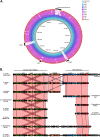Genomic Analysis of Multiresistant Staphylococcus capitis Associated with Neonatal Sepsis
- PMID: 30150477
- PMCID: PMC6201123
- DOI: 10.1128/AAC.00898-18
Genomic Analysis of Multiresistant Staphylococcus capitis Associated with Neonatal Sepsis
Abstract
Coagulase-negative staphylococci (CoNS), such as Staphylococcus capitis, are major causes of bloodstream infections in neonatal intensive care units (NICUs). Recently, a distinct clone of S. capitis (designated S. capitis NRCS-A) has emerged as an important pathogen in NICUs internationally. Here, 122 S. capitis isolates from New Zealand (NZ) underwent whole-genome sequencing (WGS), and these data were supplemented with publicly available S. capitis sequence reads. Phylogenetic and comparative genomic analyses were performed, as were phenotypic assessments of antimicrobial resistance, biofilm formation, and plasmid segregational stability on representative isolates. A distinct lineage of S. capitis was identified in NZ associated with neonates and the NICU environment. Isolates from this lineage produced increased levels of biofilm, displayed higher levels of tolerance to chlorhexidine, and were multidrug resistant. Although similar to globally circulating NICU-associated S. capitis strains at a core-genome level, NZ NICU S. capitis isolates carried a novel stably maintained multidrug-resistant plasmid that was not present in non-NICU isolates. Neonatal blood culture isolates were indistinguishable from environmental S. capitis isolates found on fomites, such as stethoscopes and neonatal incubators, but were generally distinct from those isolates carried by NICU staff. This work implicates the NICU environment as a potential reservoir for neonatal sepsis caused by S. capitis and highlights the capacity of genomics-based tracking and surveillance to inform future hospital infection control practices aimed at containing the spread of this important neonatal pathogen.
Keywords: coagulase-negative staphylococci; genomics; multidrug resistance; neonates; plasmids.
Copyright © 2018 Carter et al.
Figures


References
-
- Rasigade JP, Raulin O, Picaud JC, Tellini C, Bes M, Grando J, Ben Said M, Claris O, Etienne J, Tigaud S, Laurent F. 2012. Methicillin-resistant Staphylococcus capitis with reduced vancomycin susceptibility causes late-onset sepsis in intensive care neonates. PLoS One 7:e31548. doi:10.1371/journal.pone.0031548. - DOI - PMC - PubMed
-
- Butin M, Rasigade JP, Martins-Simoes P, Meugnier H, Lemriss H, Goering RV, Kearns A, Deighton MA, Denis O, Ibrahimi A, Claris O, Vandenesch F, Picaud JC, Laurent F. 2016. Wide geographical dissemination of the multiresistant Staphylococcus capitis NRCS-A clone in neonatal intensive-care units. Clin Microbiol Infect 22:46–52. doi:10.1016/j.cmi.2015.09.008. - DOI - PubMed
Publication types
MeSH terms
Substances
LinkOut - more resources
Full Text Sources
Other Literature Sources

